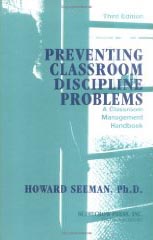|
 |
| Teachers.Net Gazette Vol.6 No.3 | March 2009 |
Subscribe for free home delivery |
|
What’s Wrong With Teacher Education In This Country? | ||
| by Howard Seeman, Ph.D.
Continued from page 2 |
||
 "the picture problem": When a teacher asks me, "Prof. Seeman, how should I handle a class clown?!" my response first is to ask: "Is he funny?" With my answer, this teacher looks at me questioningly. Why did I answer that way? Because when this question is asked, we all think of different class clowns, different kids. Similarly, with the question: But we do not have to wait for this in-the-field experience. We can do this training right in the college classroom. We can role play and simulate the specific problem, diagnose possible causes of the disruptive behavior, and help teachers practice congruent, effective responses. A troubled teacher can show us how Johnny responds when she does x. Then, we can teach her guidelines for handling, e.g., "back-talk", and how to follow these guidelines her way, by doing what is congruent for her. Then, in the final semester, we can nail these skills down more when she gets to student teaching. For example, for me, if the "class clown" is funny, and makes me laugh, I do what is congruent for me: There are also guidelines for effective rules that teachers can learn; and then, within them, help them to be themselves as they follow these. It is also difficult to train teachers to prevent and handle, e.g., discipline problems because many teachers are simply embarrassed to talk about these problems. In faculty lounges, they talk about their weekends, not that Johnny made a fool of them in period 3. Thus, in order to train teachers in classroom management, we need to first help teachers feel unalone with these problems. We need to learn how to build a trust level in education classes. We need to help teachers find support for, and with, each other. We can. We need to help teachers not with just how to handle, e.g., discipline problems, but with how to prevent these problems. The best time to fix a problem is before it becomes one. We need to help teachers diagnose and locate the CAUSES of disruptive behavior, e.g., why Johnny became a brat seven minutes into the lesson. Of course, it is not all the teacher's fault. But, some teachers know how to channel his behavior even before he becomes disruptive. We need to train teachers in these skills.
| ||
|


